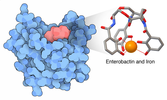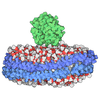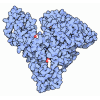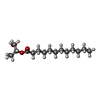[English] 日本語
 Yorodumi
Yorodumi- PDB-7k3i: Cellular retinol-binding protein 2 (CRBP2) in complex with 2-laur... -
+ Open data
Open data
- Basic information
Basic information
| Entry | Database: PDB / ID: 7k3i | |||||||||
|---|---|---|---|---|---|---|---|---|---|---|
| Title | Cellular retinol-binding protein 2 (CRBP2) in complex with 2-lauroylglycerol | |||||||||
 Components Components | Retinol-binding protein 2 | |||||||||
 Keywords Keywords | LIPID BINDING PROTEIN / lauroylglycerol / monoacylglycerol / retinol-binding protein / lipid binding | |||||||||
| Function / homology |  Function and homology information Function and homology informationvitamin A metabolic process / retinoid binding / retinal binding / retinol binding / epidermis development / Retinoid metabolism and transport / fatty acid transport / fatty acid binding / nucleus / cytosol Similarity search - Function | |||||||||
| Biological species |  Homo sapiens (human) Homo sapiens (human) | |||||||||
| Method |  X-RAY DIFFRACTION / X-RAY DIFFRACTION /  SYNCHROTRON / SYNCHROTRON /  MOLECULAR REPLACEMENT / Resolution: 1.2 Å MOLECULAR REPLACEMENT / Resolution: 1.2 Å | |||||||||
 Authors Authors | Adams, C. / Silvaroli, J.A. / Banarjee, S. / Golczak, M. | |||||||||
| Funding support |  United States, 2items United States, 2items
| |||||||||
 Citation Citation |  Journal: J.Lipid Res. / Year: 2021 Journal: J.Lipid Res. / Year: 2021Title: Molecular basis for the interaction of cellular retinol binding protein 2 (CRBP2) with nonretinoid ligands. Authors: Silvaroli, J.A. / Plau, J. / Adams, C.H. / Banerjee, S. / Widjaja-Adhi, M.A.K. / Blaner, W.S. / Golczak, M. | |||||||||
| History |
|
- Structure visualization
Structure visualization
| Structure viewer | Molecule:  Molmil Molmil Jmol/JSmol Jmol/JSmol |
|---|
- Downloads & links
Downloads & links
- Download
Download
| PDBx/mmCIF format |  7k3i.cif.gz 7k3i.cif.gz | 118.6 KB | Display |  PDBx/mmCIF format PDBx/mmCIF format |
|---|---|---|---|---|
| PDB format |  pdb7k3i.ent.gz pdb7k3i.ent.gz | 91.7 KB | Display |  PDB format PDB format |
| PDBx/mmJSON format |  7k3i.json.gz 7k3i.json.gz | Tree view |  PDBx/mmJSON format PDBx/mmJSON format | |
| Others |  Other downloads Other downloads |
-Validation report
| Summary document |  7k3i_validation.pdf.gz 7k3i_validation.pdf.gz | 651.7 KB | Display |  wwPDB validaton report wwPDB validaton report |
|---|---|---|---|---|
| Full document |  7k3i_full_validation.pdf.gz 7k3i_full_validation.pdf.gz | 651.7 KB | Display | |
| Data in XML |  7k3i_validation.xml.gz 7k3i_validation.xml.gz | 12.3 KB | Display | |
| Data in CIF |  7k3i_validation.cif.gz 7k3i_validation.cif.gz | 19.4 KB | Display | |
| Arichive directory |  https://data.pdbj.org/pub/pdb/validation_reports/k3/7k3i https://data.pdbj.org/pub/pdb/validation_reports/k3/7k3i ftp://data.pdbj.org/pub/pdb/validation_reports/k3/7k3i ftp://data.pdbj.org/pub/pdb/validation_reports/k3/7k3i | HTTPS FTP |
-Related structure data
| Related structure data |  7jvgSC  7jvyC  7jwdC  7jwrC  7jx2C  7jz5C S: Starting model for refinement C: citing same article ( |
|---|---|
| Similar structure data |
- Links
Links
- Assembly
Assembly
| Deposited unit | 
| ||||||||
|---|---|---|---|---|---|---|---|---|---|
| 1 |
| ||||||||
| Unit cell |
|
- Components
Components
| #1: Protein | Mass: 16195.246 Da / Num. of mol.: 1 Source method: isolated from a genetically manipulated source Source: (gene. exp.)  Homo sapiens (human) / Gene: RBP2, CRBP2 / Production host: Homo sapiens (human) / Gene: RBP2, CRBP2 / Production host:  |
|---|---|
| #2: Chemical | ChemComp-VLZ / |
| #3: Water | ChemComp-HOH / |
| Has ligand of interest | Y |
-Experimental details
-Experiment
| Experiment | Method:  X-RAY DIFFRACTION / Number of used crystals: 1 X-RAY DIFFRACTION / Number of used crystals: 1 |
|---|
- Sample preparation
Sample preparation
| Crystal | Density Matthews: 2.49 Å3/Da / Density % sol: 50.59 % |
|---|---|
| Crystal grow | Temperature: 293 K / Method: vapor diffusion, sitting drop / pH: 8 / Details: Tris/HCl Ph 8.0, PEG3350 20%-25% |
-Data collection
| Diffraction | Mean temperature: 90 K / Serial crystal experiment: N |
|---|---|
| Diffraction source | Source:  SYNCHROTRON / Site: SYNCHROTRON / Site:  APS APS  / Beamline: 24-ID-E / Wavelength: 0.9792 Å / Beamline: 24-ID-E / Wavelength: 0.9792 Å |
| Detector | Type: DECTRIS EIGER X 16M / Detector: PIXEL / Date: Jul 18, 2019 |
| Radiation | Protocol: SINGLE WAVELENGTH / Monochromatic (M) / Laue (L): M / Scattering type: x-ray |
| Radiation wavelength | Wavelength: 0.9792 Å / Relative weight: 1 |
| Reflection | Resolution: 1.2→64.56 Å / Num. obs: 51014 / % possible obs: 98.8 % / Redundancy: 6.4 % / CC1/2: 0.998 / Rmerge(I) obs: 0.071 / Rpim(I) all: 0.045 / Rrim(I) all: 0.085 / Net I/σ(I): 8.4 |
| Reflection shell | Resolution: 1.2→1.22 Å / Rmerge(I) obs: 0.899 / Num. unique obs: 2139 / CC1/2: 0.671 / Rpim(I) all: 0.664 / % possible all: 85.6 |
- Processing
Processing
| Software |
| ||||||||||||||||||||||||||||||||||||||||||||||||||||||||||||||||||||||||||||||||||||||||||||||||||||||||||||||||
|---|---|---|---|---|---|---|---|---|---|---|---|---|---|---|---|---|---|---|---|---|---|---|---|---|---|---|---|---|---|---|---|---|---|---|---|---|---|---|---|---|---|---|---|---|---|---|---|---|---|---|---|---|---|---|---|---|---|---|---|---|---|---|---|---|---|---|---|---|---|---|---|---|---|---|---|---|---|---|---|---|---|---|---|---|---|---|---|---|---|---|---|---|---|---|---|---|---|---|---|---|---|---|---|---|---|---|---|---|---|---|---|---|---|
| Refinement | Method to determine structure:  MOLECULAR REPLACEMENT MOLECULAR REPLACEMENTStarting model: 7JVG Resolution: 1.2→46.499 Å / SU ML: 0.14 / Cross valid method: FREE R-VALUE / σ(F): 1.33 / Phase error: 24.45 / Stereochemistry target values: ML
| ||||||||||||||||||||||||||||||||||||||||||||||||||||||||||||||||||||||||||||||||||||||||||||||||||||||||||||||||
| Solvent computation | Shrinkage radii: 0.9 Å / VDW probe radii: 1.11 Å / Solvent model: FLAT BULK SOLVENT MODEL | ||||||||||||||||||||||||||||||||||||||||||||||||||||||||||||||||||||||||||||||||||||||||||||||||||||||||||||||||
| Refinement step | Cycle: LAST / Resolution: 1.2→46.499 Å
| ||||||||||||||||||||||||||||||||||||||||||||||||||||||||||||||||||||||||||||||||||||||||||||||||||||||||||||||||
| Refine LS restraints |
| ||||||||||||||||||||||||||||||||||||||||||||||||||||||||||||||||||||||||||||||||||||||||||||||||||||||||||||||||
| LS refinement shell |
| ||||||||||||||||||||||||||||||||||||||||||||||||||||||||||||||||||||||||||||||||||||||||||||||||||||||||||||||||
| Refinement TLS params. | Method: refined / Origin x: 4.6575 Å / Origin y: 10.8772 Å / Origin z: 15.8687 Å
| ||||||||||||||||||||||||||||||||||||||||||||||||||||||||||||||||||||||||||||||||||||||||||||||||||||||||||||||||
| Refinement TLS group | Selection details: all |
 Movie
Movie Controller
Controller


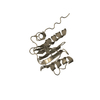

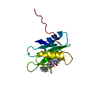

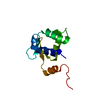
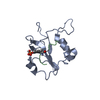
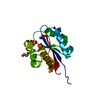
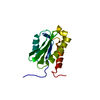

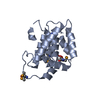
 PDBj
PDBj